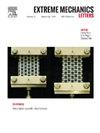使用数字体积相关和原子力显微镜对皮质骨的定向相关力学性能和骨折扩展进行多尺度研究
IF 4.5
3区 工程技术
Q2 MATERIALS SCIENCE, MULTIDISCIPLINARY
引用次数: 0
摘要
本研究研究了牛皮质骨的取向相关力学性能和骨折扩展行为,重点研究了板层平面取向及其内部层次结构的作用,这两者对骨的机械强度和抗骨折性至关重要。通过结合力学测试、微计算机断层扫描(micro-CT)、数字体积相关(DVC)和原子力显微镜(AFM),我们研究了皮质骨的区域和方向相关的力学特性,以及受底层微观结构影响的裂纹扩展。在亚毫米尺度下,通过原位三点弯曲和DVC捕获三维位移和应变,可以详细了解裂纹扩展过程中的内部变形模式。在与加载面平行和垂直的层状面方向下,骨试样的裂纹扩展行为明显。对裂纹截面进行了AFM纳米力学映射,揭示了分层层状结构内的非均匀力学性能。这些微米尺度的测量结果来自正交裂纹截面,有助于解释弯曲实验中观察到的不同裂纹扩展机制。我们的研究结果表明,层状面相对于加载面的取向在决定裂纹路径和局部应变分布方面起着关键作用。层状面是丛状和骨状骨的基本结构成分。DVC和AFM的综合应用为皮质骨的骨折抵抗提供了一个多尺度的视角。这些见解对骨植入物仿生材料的设计和改善骨折风险的临床评估具有重要意义。本文章由计算机程序翻译,如有差异,请以英文原文为准。
Multi-scale investigation of orientation-dependent mechanical properties and fracture propagation in cortical bone using digital volume correlation and atomic force microscopy
This study investigates the orientation-dependent mechanical properties and fracture propagation behavior in bovine cortical bone, focusing on the role of lamellar plane orientation and its internal hierarchical structures—both of which are critical to bone mechanical strength and fracture resistance. By combining mechanical testing, micro-computed tomography (micro-CT), digital volume correlation (DVC), and atomic force microscopy (AFM), we examined region- and orentation-dependent mechanical properties of cortical bone, as well as the crack propagation influenced by underlying microstructures. At sub-millimeter scale, three-dimensional (3D) displacement and strain captured through in situ three-point bending and DVC provided detailed insights into internal deformation patterns during crack propagation. Distinct crack propagation behaviors were observed in bone samples with lamellar planes oriented parallel and perpendicular to the loading plane. AFM nanomechanical mapping was performed on cracked cross-sections, revealing the heterogeneous mechanical properties within the hierarchical lamellar structure. These micrometer-scale measurements, obtained from orthogonal cracked cross-sections, help explain the different crack propagation mechanisms observed during the bending experiments. Our findings demonstrate that the orientation of lamellar plane— the fundamental structural component of both plexiform and osteonal bone—relative to the loading plane plays a critical role in determining crack paths and local strain distribution. The integrated application of DVC and AFM provides a multiscale perspective on fracture resistance in cortical bone. These insights have important implications for the design of biomimetic materials in bone implants and for improving clinical assessments of fracture risk.
求助全文
通过发布文献求助,成功后即可免费获取论文全文。
去求助
来源期刊

Extreme Mechanics Letters
Engineering-Mechanics of Materials
CiteScore
9.20
自引率
4.30%
发文量
179
审稿时长
45 days
期刊介绍:
Extreme Mechanics Letters (EML) enables rapid communication of research that highlights the role of mechanics in multi-disciplinary areas across materials science, physics, chemistry, biology, medicine and engineering. Emphasis is on the impact, depth and originality of new concepts, methods and observations at the forefront of applied sciences.
 求助内容:
求助内容: 应助结果提醒方式:
应助结果提醒方式:


